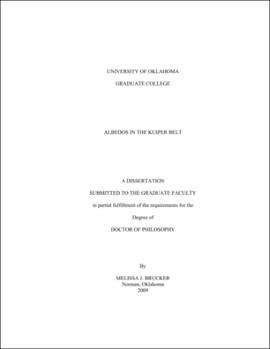| dc.contributor.advisor | Romanishin, William J. | |
| dc.creator | Brucker, Melissa Julianne | |
| dc.date.accessioned | 2019-05-01T17:24:33Z | |
| dc.date.available | 2019-05-01T17:24:33Z | |
| dc.date.issued | 2009 | |
| dc.identifier | 99132816502042 | |
| dc.identifier.uri | https://hdl.handle.net/11244/319465 | |
| dc.description.abstract | I have focused my research on the visual geometric albedos of transneptunian objects (TNOs), how the albedo varies with dynamical class, and whether or not it is correlated to orbital parameters. TNOs are among the least-processed objects in the solar system. By studying them, we can learn about the conditions in the solar system: the density of matter in the protoplanetary disk, the composition of different primordial regions, planetary migration, stirring of the disk, stellar close encounters, collision histories, binary capture, and space weathering. What we learn about how our solar system evolved also can be applied to debris disks surrounding other stars. | |
| dc.description.abstract | Using infrared images from the Multiband Imaging Photometer for Spitzer (MIPS) on the Spitzer Space Telescope (SST), I measured the thermal flux in two different wavelength bands for sixteen transneptunian objects with point-spread function (PSF) fitting photometry. I converted the measurements to monochromatic flux densities at 23.68 μm and 71.42 μm. Next, I fit the Standard Thermal Model (STM), employing a linear function for the phase integral and Monte Carlo simulations, to the flux measurements and the absolute visual magnitude for each object in order to constrain its albedo and radius. Fitting a thermal model to infrared thermal radiation measurements resolves the ambiguity found with visual reflected radiation between a small object with a high albedo and a large object with a low albedo as they would have different temperatures. Once accurate albedos and radii are determined, they can be applied to size and mass distributions of the Kuiper belt. | |
| dc.description.abstract | The sample was constructed from new targets and those previously published in the work of Stansberry et al. (2008), Grundy et al. (2005), and Grundy et al. (2009). A correlation was found between albedo and inclination for Classical Kuiper belt objects (KBOs) not including inner Classicals. The dynamically cold Classicals have higher albedos than hot Classicals. The albedos of the two populations are drawn from different parent distributions if one assumes an inclination break between them of 2.4º to 8.8º. It has already been shown that cold Classicals and hot Classicals differ in color, magnitude, and binary fraction. The high albedos of cold Classicals extend support for orbital dynamic theories that involve different formation regions, methods of transport, or surface alterations for the hot and cold Classical KBO populations. In addition, the high albedos found for cold Classical KBOs reduce the estimate for the total mass in this region by almost an order of magnitude. | |
| dc.format.extent | 133 pages | |
| dc.format.medium | application.pdf | |
| dc.language | en_US | |
| dc.relation.requires | Adobe Acrobat Reader | |
| dc.subject | Kuiper Belt | |
| dc.subject | Trans-Neptunian objects | |
| dc.subject | Infrared albedo | |
| dc.title | Albedos in the Kuiper Belt | |
| dc.type | text | |
| dc.type | document | |
| dc.thesis.degree | Ph.D. | |
| ou.group | College of Arts and Sciences::Homer L. Dodge Department of Physics and Astronomy | |
